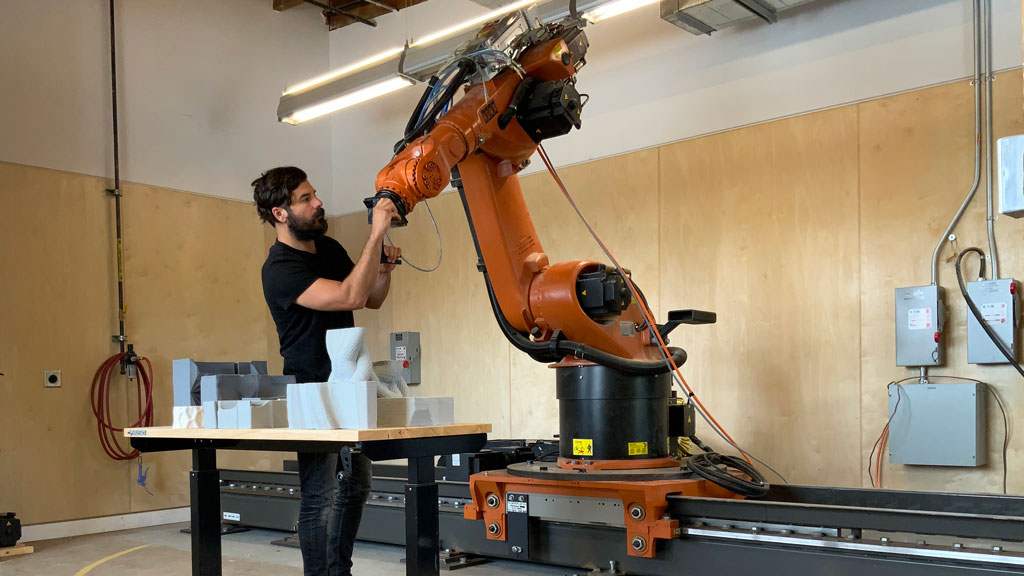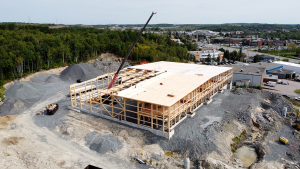A research team based in Sudbury, Ont. is developing a robot to automate the fabrication of anything from a stick of furniture to a building project.
“It is about exploring the integration of digital (design and fabrication) tools that hopefully can act as a catalyst to help revitalize northern communities…providing residents with local building solutions,” explains Steven Beites, professor at Laurentian University’s McEwen School of Architecture.
Beites is leading the research team which includes staff from the Bharti School of Engineering and the Behavioural Neuroscience Department at Laurentian University.
Their agenda is to tackle the development of a portable, user-friendly cable-driven parallel robot (CDPR) for wide-ranging applications.
That objective is novel for a number of reasons, including that the robot can work in-situ such as on a housing project, unlike its traditional counterpart that remains in a factory.
Employing winches and cables, CDPRs are digitally programmed robots, similar to a Skycam, which build an object, big or small, from blueprints, says Beites who specializes in emergent design and robotics at the school of architecture.
“The advantage of a CDPR, versus an industrial robot, is it is much more cost effective. It can span large distances and it is mobile and portable.”
By creating a user-friendly platform with the aid of the Behavioural Neuroscience Department, the CDPR should be accessible to “non-professionals,” not just architects and other building professionals.
That interface could feature “action buttons” for simple control from an iPad or iPhone, eliminating the need for complex online software.
Audio commands and augmented reality to activate the CDPR are also being considered, he points out.
“We’re not saying that the CDPR is suddenly going to automate the construction process; it is more of a collaborative tool.”
Beites says CDPRs have been explored for architectural applications, but unlike the Laurentian project, they tend to be small, proof-of-concept models operating only from a controlled environment.
Laurentian’s portable version would offer northern Ontario communities steps towards self-reliance, freeing them from dependency on southern Ontario for materials, design and manufacturing.
So far the team has developed the requirements and components for the CDPR at the architecture school’s digital fabrication lab which includes an industrial robot on a linear track to test and ultimately “push the boundaries” of various architectural applications. Their work includes “revisiting” traditional construction methods and looking at new ways of using materials.
Research is currently focussed on a proof-of-concept prototype of the platform, which they hope is ready for testing early next year, says Beites.
“There are a lot of elements that we can continue to add…and I am sure there will be some remodelling and redesigning.”
There are three tools under development for the CDPR: a 3D printer typically used for printing of materials and tools; a spindle to work with timber; and a vacuum gripper for assembly of materials such as bricks and blocks on site.
Beites says the architecture school’s mandate is to work with communities, possibly through workshops and design-build activities, to eliminate barriers to digital fabrication on local projects.
Ultimately, the researchers want to make the robot freely available in an open source environment where it can be tweaked and modified according to the needs of users, be it a large manufacturer or a hobbyist designing a table or dresser.
“We want to make sure it is open (to anyone).”
Beites likens the CDPR’s path to that of 3D printing which saw an accelerated evolution once its patent was lifted.
The research project has received a two-year $250,000 grant from the New Frontiers Research Fund, an initiative of the federal government’s Canada Research Coordinating Committee.
While Beites is excited about the multitude of discoveries that might lie ahead as a result of the team’s progress over the next few years, he says what motivates him is the possibilities that “open up creative digital fabrication” for the ordinary, everyday non-professional user.
“It will be good for our region.”











Recent Comments
comments for this post are closed